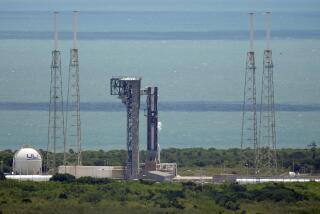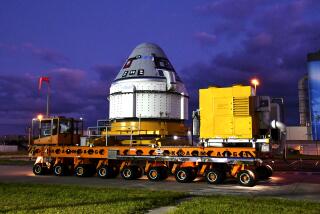Cold Postpones Shuttle Launch : Threat of Fuel Tank Ice Prompts 24-Hour Delay
KENNEDY SPACE CENTER, Fla. — The deep freeze that has enveloped the East Coast delayed for at least 24 hours today’s scheduled launch of the space shuttle Discovery, which is to carry a super-secret military spy cargo.
National Aeronautics and Space Administration officials feared that chunks of ice would form on the towering external fuel tank that the shuttle would ride off launch pad 39A.
The ice could add unnecessary weight to the orbiter. In addition, by tumbling off in great sheets under the thrust of liftoff, it could pose the risk of damage to the heat-shielding tiles that are designed to keep the spacecraft from burning up when it enters the Earth’s atmosphere at the end of its mission.
With the temperature dropping quickly through the low 30s and expected to reach 27 degrees in the early-morning hours, space agency officials decided at 11:45 p.m. Tuesday to postpone the mission. Today’s high temperature was expected to reach the mid-50s, and tonight’s lower temperature was not expected to be so severe that it would cause additional problems.
“Extreme weather conditions in the area are projected to cause icy conditions on the external tank,” NASA spokesman Hugh Harris said shortly before midnight.
Another space agency spokesman, Jim Mizell, said that, with the shuttle sitting on its launch pad a mile from the Atlantic Ocean in a stiff wind, there was “a good chance” that it would pick up a coating of ice overnight and that the sheets would not melt in time for the afternoon liftoff.
The delay gave engineers additional time to evaluate the impact that the freezing temperatures have had on the water-filled firefighting system that runs through the launch tower like a giant web.
“It’s the same as the plumbing in your house freezing,” NASA spokesman Charles Redmond said, expressing concern that too many tubes and valves may have become stuck or cracked to provide adequate firefighting capabilities.
Technicians placed anti-freeze in the network to ward off more damage, a space agency official said.
On the day of the launch, liquid hydrogen fuel will be loaded into the main tank. The fuel’s fumes are highly flammable.
“We don’t want a lot of gaseous hydrogen around if the fire suppressant system isn’t working,” Redmond said.
Some Pipes Ruptured
“Teams crawling all over the gantry” discovered that some valves in the system had become stuck and that some pipes had ruptured, he said.
“There is a massive amount of plumbing to put out small fires. A lot of that is frozen,” Redmond said. “Normally, we do not have this kind of weather condition.”
From indoors Tuesday, the space complex grounds appeared much as they do under normal conditions. The sky was nearly cloudless, and the sun cast sharp shadows. But the temperature Tuesday afternoon barely reached the high 40s.
But for the spaceship’s cargo, this 15th shuttle mission would be a routine matter. The secrecy surrounding the payload, assembled by the Air Force, has nearly frozen the normally free-flowing NASA public relations spigot.
Countdown clocks, which would display the hours and minutes remaining before a normal launch, were blank, and the countdown procedures continued in secrecy.
Space agency officials said that, under their agreement with the Air Force, they would give only nine minutes’ warning of the launch.
They made it clear that the Air Force would have preferred that no advance announcement be issued. But NASA officials argued that anyone near the space complex could predict the launch time by certain standard pre-launch activities that could be seen from public roads. In addition, Soviet trawlers and aircraft routinely crisscross the launch vicinity.
NASA’s interest in publicizing its operations--as part of its effort to attract paying customers to the shuttle, as well as congressional budget support--has conflicted with the Air Force’s concern that any information about the flight could make it easier for the Soviet Union to track the eavesdropping satellite that the shuttle is reportedly supposed to send to an orbit 22,300 miles above the Earth.
More to Read
Sign up for Essential California
The most important California stories and recommendations in your inbox every morning.
You may occasionally receive promotional content from the Los Angeles Times.










